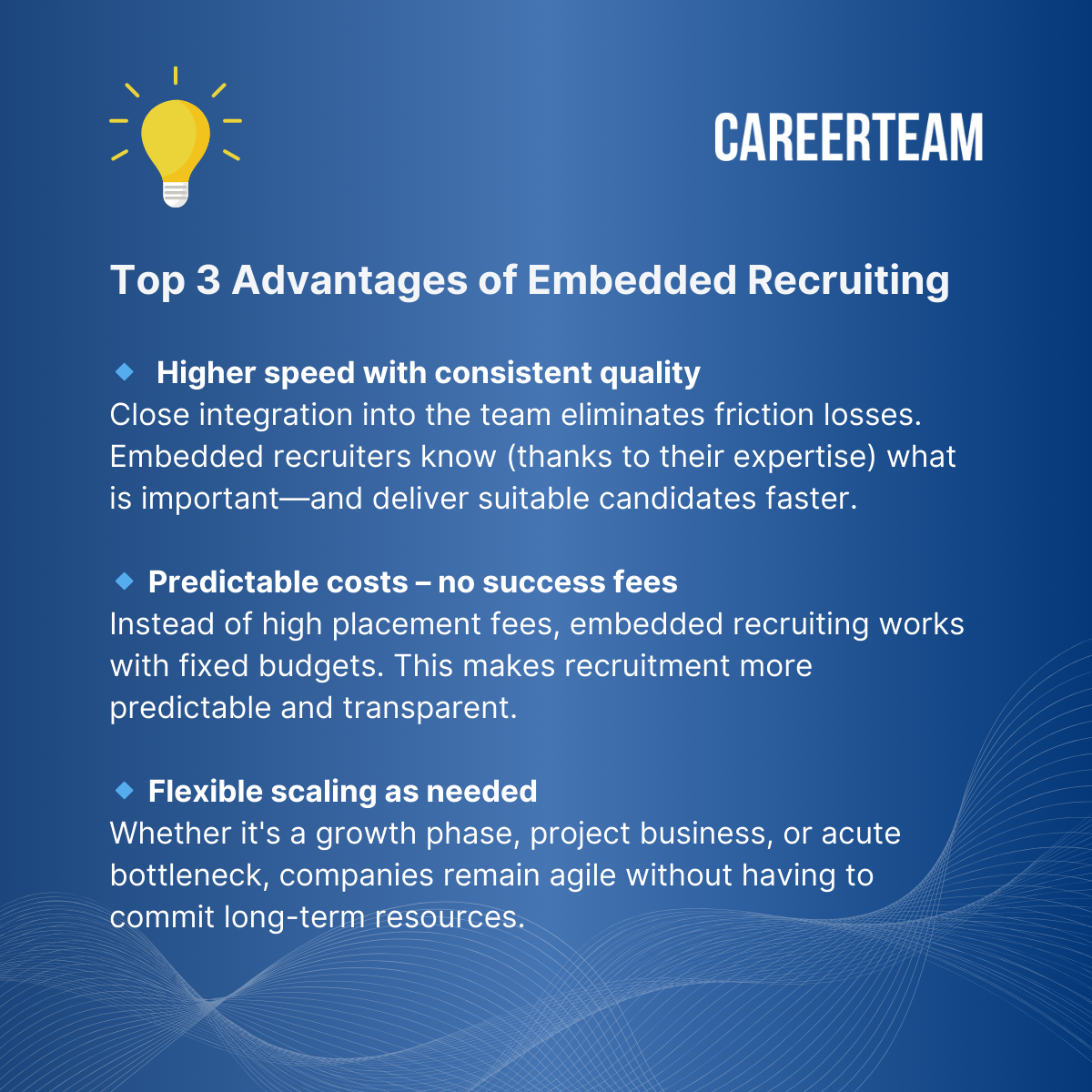When resources are scarce, recruitment improves.
Sounds contradictory? It is... at least at first glance.
Despite budget cuts, hiring freezes, and a creeping shortage of skilled workers setting the tone in many places, some companies are managing to recruit new employees in a targeted and efficient manner right now. What sets them apart is not another tool or a new metric. Instead, it is a structural approach that fundamentally rethinks the recruiting process: embedded recruiting.
It's not about traditional placement. Nor is it about external agencies with contingency fees. It's about temporary recruiting, integrated into the team, practical, and effective immediately. It's a solution that enables companies to take action when there's nothing left to distribute. And it shows that those who reorganize their recruiting can turn crises into opportunities.
What is embedded recruiting and how does it differ from the traditional model?
Recruiting agency or in-house team? Most companies only know these two options when it comes to filling open positions. Embedded recruiting introduces a third option – one that is structurally different but feels the same operationally and internally.
Embedded recruiting means that external recruiters work on a temporary basis as an integrated part of the company. They actively take on operational recruiting, act under the employer brand, use internal tools, and coordinate closely with specialist departments. Rather than being service providers in the background, they are visible and committed within the organization.
What distinguishes this model from traditional agencies is its proximity: while intermediaries usually work at a distance and on a performance-related basis, embedded recruiters are directly involved in processes – from clarifying requirements and sourcing to making the final offer. They are in direct contact with hiring managers. Communication with applicants takes place via the company's own email addresses.
In many cases, they even take part in daily stand-ups or strategic HR meetings.
In this context, ‘embedded’ literally means integrated into structures and involved in decisions. And that is precisely what sets it apart from traditional recruitment. Whereas agencies are often paid on a commission basis, embedded recruiting is all about the success of the project: multiple hires, faster processes, better matches. Everything from a single source.
At the same time, embedded recruiting also differs from traditional in-house teams: instead of fixed costs and long-term commitments, the focus here is on flexibility and temporary expertise. Companies bring targeted recruiting capacity in-house . For example, during periods of rapid growth, turnarounds, or when special roles need to be filled at short notice. And they end the project when their staffing needs are met.
Embedded recruiting is therefore often used when internal resources reach their limits.
Quality and efficiency in harmony: Why embedded recruiting scales better
Efficiency is often seen as the enemy of quality. This seems to be particularly true in recruiting: those who hire faster make more mistakes. On the other hand, those who select more carefully lose talent to the competition.
Embedded recruiting breaks this contradiction.
That's because embedded recruiters don't work under external pressure. They work with internal access. They know the culture, understand the team, and are involved in all processes. This allows them to pre-sort candidates instead of just “delivering” profiles. They are not tied to commissions. They are tied to a common goal: finding the right person, not just anyone.
An additional advantage is the time-to-fill. According to StepStone Recruiting Trends 2025, the average time to fill a position has currently skyrocketed to 180 days (StepStone 2025). Embedded recruiting can significantly reduce this time. This is because integration into the team eliminates coordination loops, queries, and unnecessary bureaucracy.
Decisions are made faster because information is available first-hand.
What's more, an embedded recruiter does not just fill one position. Often, several roles are handled in parallel – with the same setup. This makes the process scalable: multiple hires, one contact person, one workflow. And that's without the additional costs per hire that traditional agencies charge.
It also benefits the candidate experience. Applicants experience consistent communication, consistent messages, and quick feedback, often directly on behalf of the company. There is no feeling of outsourcing or referral to third parties. Instead, an (internal) dialogue develops that builds trust and that is precisely what determines the quality of the candidate experience.
Above all, embedded recruiting is efficient because of its proximity to the organization.
Recruiting under cost pressure – how embedded recruiting conserves resources
Recruiting takes time, money, and experience. But that's exactly what many HR teams don't have right now. According to a McKinsey survey, 44% of the companies surveyed rate their own recruiting as “not cost-effective”, despite growing demand (McKinsey 2024). The pressure to achieve more with less is real. Embedded recruiting offers a pragmatic answer.
Instead of creating additional permanent positions in the HR team, companies rely on temporary reinforcements with clear tasks. An embedded recruiter takes on specific vacancies for a defined period of time, without long-term personnel costs or additional effort in employer setup. The effort is calculable and the effect is immediately noticeable.
Another advantage is that you don't pay per hire, but per time unit. Traditional recruitment models can quickly add up to 20 to 30% of the annual salary per position filled – regardless of how many candidates the service provider rejects beforehand. Embedded recruiting, on the other hand, works on a project basis or via monthly flat rates. This means that multiple hires can be made within a planning budget - without variable additional costs.
This can be crucial, especially in growth phases or in project-based businesses: when capacity needs to be created quickly without permanently inflating the organizational structure. At the same time, embedded recruiting takes the pressure off the internal HR team. Instead of conducting every interview yourself, maintaining every funnel, and gathering every piece of feedback, the embedded recruiter takes on these tasks on behalf of the company.
And it doesn't stop at operational support: many embedded recruiters bring best practices from other industries, from previous assignments, from tried-and-tested tools and processes within the team. They not only optimize hiring. They make the recruiting team itself more efficient.
In short, embedded recruiting saves costs by avoiding unnecessary friction. And that's exactly what makes the difference when budgets are tight.

Avoiding pitfalls: Who embedded recruiting works for (and who it doesn't)
As flexible as embedded recruiting is, it is not a panacea. Like any good solution, it is only effective under the right conditions.
Embedded recruiting works particularly well in companies that are pursuing specific growth targets but are unable or unwilling to build up internal capacities in the short term. Its flexibility also pays off in transitional phases, such as reorganizations, team realignments, or the filling of key roles. The same applies in highly project-driven environments where several positions need to be filled within a few weeks without overburdening existing structures.
However, embedded recruiting relies on access and participation. Those who do not have processes in place – or do not want to share them – will benefit little from it. If the embedded recruiter does not have access to hiring managers, ATS systems, or coordination loops, the promised efficiency will fall by the wayside. Embedded recruiting only works if the external party is allowed to act as part of the team—on an equal footing, with trust and responsibility.
Another critical item is cultural fit. Embedded recruiting means proximity and proximity requires connectivity.
If the company insists on tight internal control, rigid hierarchies, or a clear separation between internal and external, collaboration can become difficult. Embedded recruiters are self-organized, think entrepreneurially, and contribute their own ideas. This must be desired. Expectations are also crucial: anyone who believes that an embedded recruiter will arrive at the company with a ready-made pool of candidates will be disappointed.
This is why embedded recruiting is not a plug-and-play solution. But under the right conditions, it becomes an accelerator. For speed, quality, and team structure.
From tactical solution to strategic partnership
Many companies only discover embedded recruiting when the going gets tough: acute staffing needs, overworked HR teams, internal chaos. In such cases, an embedded recruiter can help fill vacancies more effectively and stabilize processes. But the potential of this model goes far beyond that.
Embedded recruiting can be understood as a building block of modern HR architecture. It fits into organizations that consciously opt for flexible capacity management, in recruiting as well as in other areas. Instead of permanently creating new positions, companies react dynamically: they bring in expertise when they need it and release it again when the phase is complete.
The model is also gaining importance with regard to strategic workforce planning. Embedded recruiters not only relieve the operational burden, but also provide data, patterns, and experience that can be incorporated into long-term personnel planning. Which profiles are difficult to find? How many interviews are needed per position? Where are we losing candidates in the funnel? Questions like these can sometimes be answered better when recruiting is observed from within rather than from outside.
Embracing embedded recruiting is more than just a pragmatic stopgap measure. It can become the interface between operational implementation and strategic management. Those who manage to integrate embedded recruiting not only in the short term but systematically gain a unique perspective that traditional service providers cannot offer: an insider's view with the independence of an outsider.
Conclusion
Rethinking recruiting means reorganizing structures. In this context, embedded recruiting is not a tool or a method, but rather a change of perspective. Instead of stretching resources, they are used strategically. Instead of accelerating processes, they are brought closer to the business. Quality and efficiency are no longer a contradiction, but rather the result of a different setup.
Particularly in economically challenging times, no company can afford to give recruiting a free rein. When budgets are shrinking and demand is rising, solutions are needed that have an immediate impact. Embedded recruiting is one such solution. It is not a short-term hack, but rather a form of organization that starts where recruiting needs to be effective today: from within.
You don't want to keep hiring on a long leash any longer, but you don't have the internal resources?
Then embedded recruiting may be exactly the solution you've been missing. CareerTeam thinks about recruiting with you from the inside. Scalable, reliable, and close to your business.
Let's find out together how you can attract the right candidates faster and more effectively. We look forward to talking to you.
Sources
- CareerTeam (2025): Quality or efficiency? Never compromise when recruiting!
- Foxio Consulting (2025): Top 5 cost-effective HR strategies – effective recruiting despite budget cuts
- StepStone (2025): Recruiting Trends 2025.
- McKinsey (2024): Increasing your return on talent: The moves and metrics that matter.










.png)




